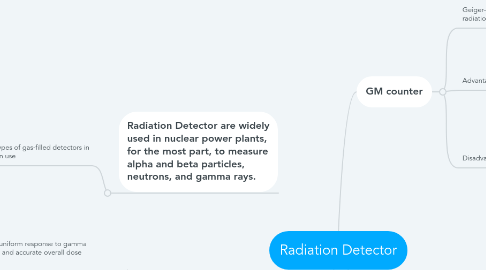
1. Radiation Detector are widely used in nuclear power plants, for the most part, to measure alpha and beta particles, neutrons, and gamma rays.
1.1. Three types of gas-filled detectors in common use
1.1.1. Ionization chambers (continuous current output)
1.1.2. Proportional counters (pulse current output)
1.1.3. Geiger Muller counters (pulse current output)
2. Ionization Chamber
2.1. Advantages
2.1.1. 1. good uniform response to gamma radiation and accurate overall dose reading
2.1.2. 2. capable of measuring very high radiation rates, sustained high radiation levels do not degrade the fill gas.
2.2. Disadvantages
2.2.1. 1. low output requiring sophisticated electrometer circuit
2.2.2. 2. operation and accuracy easily affected by moisture.
2.3. ionization chamber measures the charge from the number of ion pairs created within a gas caused by incident radiation.
2.3.1. The chamber cannot discriminate between radiation types (beta or gamma) and cannot produce an energy spectrum of radiation.
3. GM counter
3.1. Geiger–Müller counter a hand-held radiation survey instrument
3.1.1. consists of a GM tube, the sensing
3.1.1.1. Geiger counters are widely used to detect gamma radiation, and for this the windowless tube is used
3.2. Advantages
3.2.1. 1. cheap detector with a large variety of sizes and applications,
3.2.2. 2.large output signal is produced from tube
3.2.3. 3. can measure the overall gamma dose when using an energy compensated tube.
3.3. Disadvantages
3.3.1. 1. cannot measure the energy of the radiation (no spectrographic information)
3.3.2. 2. Can not measure high radiation rates due to dead time
4. Proportional Counter
4.1. Advantages
4.1.1. 1. ability to measure energy of radiation and provide spectrographic information,
4.1.2. 2. discriminate between alpha and beta particles, and that large area detectors can be constructed
4.2. Disadvantages
4.2.1. 1. anode wires delicate and can lose efficiency in gas flow detectors due to deposition,
4.2.2. 2. the efficiency and operation affected by ingress of oxygen into fill gas, and measurement windows easily damaged in large area detectors.
4.3. Proportional counters operate at a slightly higher voltage, selected such that discrete avalanches are generated.
4.3.1. Each ion pair produces a single avalanche so that an output current pulse is generated which is proportional to the energy deposited by the radiation.
4.3.1.1. This is in the "proportional counting" region.
